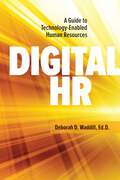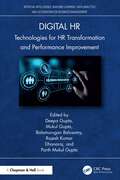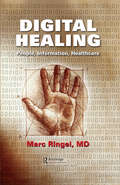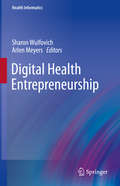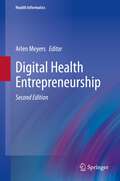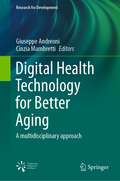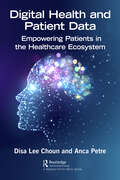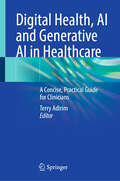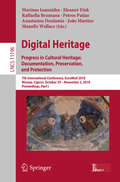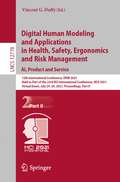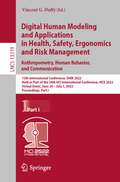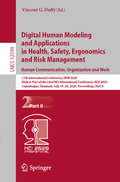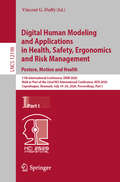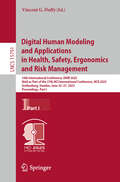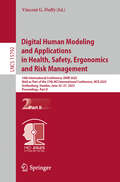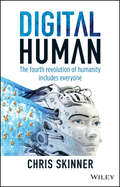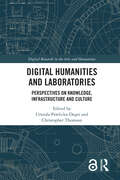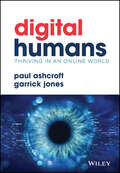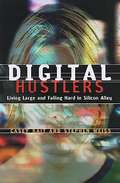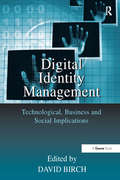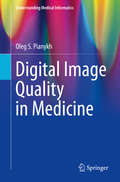- Table View
- List View
Digital HR: A Guide to Technology-Enabled Human Resources
by Deborah WaddillIt's an exciting time to be in HR as scores of technologies including AI, predictive modeling, real-time data analytics, HR shared service centers and others are being implemented at a rapid pace by HR leaders around the world every day.Digital HR expertly addresses the revolutionary trends and disruptive technologies to provide HR executives, managers, specialists, generalists and students with a comprehensive and evidence-based guide to current technologies that enhance, enable, revitalize and empower Human Resources. With practical insight, real-world case studies, tips and tools, recommendations and additional resources, the author guides readers through each of the major technologies and addresses vital strategic and implementation issues.Designed for HR professionals and students at all levels, the book explores how these tools can enhance decision-making, streamline operations and create more agile, strategic HR functions.
Digital HR: Technologies for HR Transformation and Performance Improvement (Artificial Intelligence, Machine Learning, Data Analytics and Automation for Business Management)
by Balamurugan Balusamy Rajesh Kumar Dhanaraj Deepa Gupta Mukul Gupta Parth Mukul GuptaThis book explores the impact of technology on Human Resource (HR) practices and how organisations can effectively incorporate progress in technology to improve HR processes. It provides a comprehensive overview of the various advancements that are transforming HR, including artificial intelligence (AI), machine learning, big data, and blockchain. Digital HR provides real-world examples, case studies, and best practices that illustrate how organisations are successfully leveraging technology to improve their HR management (HRM) processes and outcomes. This practical orientation makes the book valuable for professionals and scholars who are interested or have actionable insights to implement technologies for HR transformation and performance improvement in their organisations. Offers case studies, best practices, and real-world examples of successful and unsuccessful HR transformation initiatives Illustrates the technological progress transforming HR, including AI, machine learning, big data, and blockchain -- HR Software Solutions Discusses challenges associated with adapting and implementing them in the various practices and processes of the HRM Studies different applications of AI and machine learning in HR, including talent acquisition, performance management, and employee engagement end-to-end technology implementation in their domain This book is intended for professionals, managers, and executives seeking an understanding of the impact of technology on the workforce and how they can leverage it to achieve their goals. It will also be useful for scholars and researchers interested in digital HR from the fields of computer science, business management, human resources, and HRM.
Digital Healing: People, Information, Healthcare
by Marc RingelMedical practice and research are inconceivable today without electronic computing and communication tools. Digital machines do many tasks orders-of-magnitude better, faster and more accurately than humans.Still, there are functions critical to the healthcare endeavor that people do much better than machines, things like: understanding and using natural language; perceiving what is unexpressed; taking into account values, culture, ethics, and human relationships; touching and healing. For the foreseeable future, the "smartest" computers will be no match for human beings when it comes to performing these most anthropic functions.American healthcare is at a critical juncture. Providers and patients are increasingly frustrated by degradation of the human relationships that lie at the core of the medical practice. Technologies, such as the computerized medical record, get much of the blame for intrusion into the patient-provider relationship. However, it is not technology itself that is to blame. The fault lies with how systems are conceived, designed, and deployed.This book analyzes how to organize the work of healthcare in a way that uses machines to do what they do best, thereby freeing humans to do what we do best. Smart use of electronic technology is crucial to the success of any bid to fulfill the Institute for Healthcare Improvement’s triple aim to make healthcare more effective, efficient, and humane.
Digital Health Entrepreneurship (Health Informatics)
by Sharon Wulfovich Arlen MeyersThis book presents a hands on approach to the digital health innovation and entrepreneurship roadmap for digital health entrepreneurs and medical professionals who are dissatisfied with the existing literature on or are contemplating getting involved in digital health entrepreneurship. Topics covered include regulatory affairs featuring detailed guidance on the legal environment, protecting digital health intellectual property in software, hardware and business processes, financing a digital health start up, cybersecurity best practice, and digital health business model testing for desirability, feasibility, and viability.Digital Health Entrepreneurship is directed to clinicians and other digital health entrepreneurs and stresses an interdisciplinary approach to product development, deployment, dissemination and implementation. It therefore provides an ideal resource for medical professionals across a broad range of disciplines seeking a greater understanding of digital health innovation and entrepreneurship.
Digital Health Entrepreneurship (Health Informatics)
by Arlen MeyersThis extensively revised book is an essential hands-on resource for all involved in digital health innovation and presents an entrepreneurship roadmap for digital health entrepreneurs and medical professionals who are contemplating getting involved. It represents a key resource to maximize the reader's knowledge when investing in this area. Topics covered include regulatory affairs featuring detailed guidance on the legal environment, protecting digital health intellectual property in software, hardware and business processes, financing a digital health start up, cybersecurity best practice and digital health business model testing for desirability, feasibility and viability. Digital Health Entrepreneurship is directed towards clinicians and other digital health entrepreneurs and stresses an interdisciplinary approach to product development, deployment, dissemination and implementation. It therefore provides an ideal resource for medical professionals across a broad range of disciplines seeking a greater understanding of digital health innovation and entrepreneurship.
Digital Health Technology for Better Aging: A multidisciplinary approach (Research for Development)
by Giuseppe Andreoni Cinzia MambrettiThis book describes the multidisciplinary approach needed to tackle better aging. Aging populations are one of the 21st century’s biggest challenges. National health systems are forced to adapt in order to provide adequate and affordable care. Innovation, driven by digital technology, is a key to improving quality of life and encouraging healthy living. Well-designed technology keeps people empowered, independent, and mobile; however, despite widespread adoption of ICT in day-to-day life, digital health technologies have yet to catch on. To this end, technology needs to be effective, usable, cheap, and designed to ensure the security of the managed data. In the era of mHealth, mobile technology, and social design, this book describes, in six sections, the collaboration of polytechnic know-how and social science and health sectors in the creation of a system for encouraging people to engage in healthy behavior and achieve a better quality of life.
Digital Health and Patient Data: Empowering Patients in the Healthcare Ecosystem
by Disa Lee Choun Anca PetrePatients with unmet needs will continue to increase as no viable nor adequate treatment exists. Meanwhile, healthcare systems are struggling to cope with the rise of patients with chronic diseases, the ageing population and the increasing cost of drugs. What if there is a faster and less expensive way to provide better care for patients using the right digital solutions and transforming the growing volumes of health data into insights? The increase of digital health has grown exponentially in the last few years. Why is there a slow uptake of these new digital solutions in the healthcare and pharmaceutical industries? One of the key reasons is that patients are often left out of the innovation process. Their data are used without their knowledge, solutions designed for them are developed without their input and healthcare professionals refuse their expertise. This book explores what it means to empower patients in a digital world and how this empowerment will bridge the gap between science, technology and patients. All these components need to co-exist to bring value not only to the patients themselves but to improve the healthcare ecosystem. Patients have taken matters into their own hands. Some are equipped with the latest wearables and applications, engaged in improving their health using data, empowered to make informed decisions and ultimately are experts in their disease(s). They are the e-patients. The other side of the spectrum are patients with minimal digital literacy but equally willing to donate their data for the purpose of research. Finding the right balance when using digital health solutions becomes as critical as the need to develop a disease-specific solution. For the first time, the authors look at healthcare and technologies through the lens of patients and physicians via surveys and interviews in order to understand their perspective on digital health, analyse the benefits for them, explore how they can actively engage in the innovation process, and identify the threats and opportunities the large volumes of data create by digitizing healthcare. Are patients truly ready to know everything about their health? What is the value of their data? How can other stakeholders join the patient empowerment movement? This unique perspective will help us re-design the future of healthcare - an industry in desperate need for a change.
Digital Health, AI and Generative AI in Healthcare: A Concise, Practical Guide for Clinicians
by Terry AdirimThe purpose of this title is to provide a comprehensive foundation for all medical professionals and healthcare-professions students in understanding Artificial Intelligence (AI). With the advent of generative AI, including the release of Open AI’s ChatGPT in 2022, the world entered a new age of rapid advancements in technology that will significantly change the way clinicians practice medicine, operate healthcare institutions, and conduct research. At the heart of this penetrating book is the idea that medical schools, medical training programs and other health education institutions must undertake a key role in developing AI literacy for clinicians across the spectrum of medical education that includes all health professions. Moreover, assert the authors, AI literacy should be incorporated within medical school curriculums as a core competency, as well as into graduate medical education training programs and continuing medical education courses. This timely and easy-to-read guide offers a wide range of chapters that discuss the core concepts and issues relating to AI in medicine, including a basic understanding of algorithms, machine learning, large language models and natural language processing, the limits and pitfalls of AI, ethical and legal issues, the evolving regulatory landscape around AI, as well as how AI is currently being used in healthcare, to name just several compelling topics. Additionally, AI technologies will change how medical school curriculums are delivered and how student competencies are assessed, maintain the authors. Therefore, medical educators will not only need to rethink how and what medical information is conveyed to students during formal instruction, but also must be prepared for AI-powered programs being used to assess students and trainees for the purpose of licensure and board certification. A timely and soon-to-be gold standard resource in the field, Digital Health, AI, and Generative AI: A Concise, Practical Guide for Clinicians will be of great interest to medical professionals, trainees, administrators, policymakers, and anyone interested in the fast-evolving intersection of digital technologies and healthcare.
Digital Healthcare in Germany: Market Access for Innovations (Contributions to Economics)
by Stefan WalzerDigital healthcare is heterogeneous along the entire treatment pathway, ranging from monitoring applications and artificial-intelligence-based diagnostics, to support for virtual reality surgery. Since the introduction of the Digital Health Act in Germany in early 2020, there has been a push toward digital innovative solutions, especially in the outpatient sector.This book analyzes current digital health law from an economic perspective, combining theory with real-world applications. It examines both the incentives and market access pathways for digital solutions and the price effects brought about by the new regulatory framework in Germany. Further, it discusses the difficulties in pricing due to the monopolistic BfArM register and negotiations with the association of all German health insurance companies. The book addresses a wide range of topics, including incentives for innovation, specifics of digital health applications, reimbursement and financing options for digital health solutions. Lastly, it presents an outlook for the future and a comparison between Germany and other countries, namely the USA and Japan. Given its scope, this book will appeal to scholars of health economics, healthcare management and public health, as well as practitioners and professionals in the public health sector.
Digital Heritage. Progress in Cultural Heritage: 6th International Conference, Euromed 2016, Nicosia, Cyprus, October 31 - November 5, 2016, Proceedings, Part I (Lecture Notes in Computer Science #10058)
by Marinos Ioannides Eleanor Fink João Martins Raffaella Brumana Petros Patias Anastasios Doulamis Manolis WallaceThis two-volume set LNCS 11196 and LNCS 11197 constitutes the refereed proceedings of the 7th International Conference on Digital Heritage, EuroMed 2018, held in Nicosia, Cyprus, in October/November 2018. The 21 full papers, 47 project papers, and 29 short papers presented were carefully reviewed and selected from 537 submissions. The papers are organized in topical sections on 3D Digitalization, Reconstruction, Modeling, and HBIM; Innovative Technologies in Digital Cultural Heritage; Digital Cultural Heritage –Smart Technologies; The New Era of Museums and Exhibitions; Digital Cultural Heritage Infrastructure; Non Destructive Techniques in Cultural Heritage Conservation; E-Humanities; Reconstructing the Past; Visualization, VR and AR Methods and Applications; Digital Applications for Materials Preservation in Cultural Heritage; and Digital Cultural Heritage Learning and Experiences.
Digital Human Modeling and Applications in Health, Safety, Ergonomics and Risk Management. AI, Product and Service: 12th International Conference, DHM 2021, Held as Part of the 23rd HCI International Conference, HCII 2021, Virtual Event, July 24–29, 2021, Proceedings, Part II (Lecture Notes in Computer Science #12778)
by Vincent G. DuffyThis two-volume set LNCS 12777 and 12778 constitutes the thoroughly refereed proceedings of the 12th International Conference on Digital Human Modeling and Applications in Health, Safety, Ergonomics and Risk Management, DHM 2021, which was held virtually as part of the 23rd HCI International Conference, HCII 2021, in July 2021.The total of 1276 papers and 241 posters included in the 39 HCII 2021 proceedings volumes was carefully reviewed and selected from 5222 submissions. DHM 2021 includes a total of 56 papers; they were organized in topical sections named: Part I, Human Body, Motion and Behavior: Ergonomics, human factors and occupational health; human body and motion modeling; and language, communication and behavior modeling. Part II, AI, Product and Service: Rethinking healthcare; artificial intelligence applications and ethical issues; and digital human modeling in product and service design.
Digital Human Modeling and Applications in Health, Safety, Ergonomics and Risk Management. Anthropometry, Human Behavior, and Communication: 13th International Conference, DHM 2022, Held as Part of the 24th HCI International Conference, HCII 2022, Virtual Event, June 26 – July 1, 2022, Proceedings, Part I (Lecture Notes in Computer Science #13319)
by Vincent G. DuffyThis two-volume set LNCS 1319 and 13320 constitutes the thoroughly refereed proceedings of the 13th International Conference on Digital Human Modeling and Applications in Health, Safety, Ergonomics and Risk Management, DHM 2022, which was held virtually as part of the 24rd HCI International Conference, HCII 2022, in June/July 2022.The total of 1271 papers and 275 poster papers included in the 39 HCII 2022 proceedings volumes was carefully reviewed and selected from 5487 submissions. DHM 2022 includes a total of 56 papers. The first volume focuses on topics related to ergonomic design, anthropometry, and human modeling, as well as collaboration, communication, and human behavior. The second volume focuses on topics related to task analysis, quality and safety in healthcare, as well as occupational health and operations management, and Digital Human Modeling in interactive product and service design.
Digital Human Modeling and Applications in Health, Safety, Ergonomics and Risk Management. Human Communication, Organization and Work: 11th International Conference, DHM 2020, Held as Part of the 22nd HCI International Conference, HCII 2020, Copenhagen, Denmark, July 19–24, 2020, Proceedings, Part II (Lecture Notes in Computer Science #12199)
by Vincent G. DuffyThis two-volume set LNCS 12198 and 12199 constitutes the thoroughly refereed proceedings of the 11th International Conference on Digital Human Modeling and Applications in Health, Safety, Ergonomics and Risk Management, DHM 2020, which was supposed to be held as part of the 22st HCI International Conference, HCII 2020, in Copenhagen, Denmark, in July 2020. The conference was held virtually due to the COVID-19 pandemic. A total of 1439 papers and 238 posters have been carefully reviewed and accepted for publication in HCII 2020. DHM 2020 includes a total of 77 papers; they were organized in topical sections named: Part I, Posture, Motion and Health: Posture and motion modelling in design; ergonomics and occupational health; applications for exercising, physical therapy and rehabilitation; health services; DHM for aging support. Part II, Human Communication, Organization and Work: Modelling human communication; modelling work, collaboration and the human environment; addressing ethical and societal challenges; new research issues and approaches in digital human modelling.
Digital Human Modeling and Applications in Health, Safety, Ergonomics and Risk Management. Posture, Motion and Health: 11th International Conference, DHM 2020, Held as Part of the 22nd HCI International Conference, HCII 2020, Copenhagen, Denmark, July 19–24, 2020, Proceedings, Part I (Lecture Notes in Computer Science #12198)
by Vincent G. DuffyThis two-volume set LNCS 12198 and 12199 constitutes the thoroughly refereed proceedings of the 11th International Conference on Digital Human Modeling and Applications in Health, Safety, Ergonomics and Risk Management, DHM 2020, which was supposed to be held as part of the 22st HCI International Conference, HCII 2020, in Copenhagen, Denmark, in July 2020. The conference was held virtually due to the COVID-19 pandemic. A total of 1439 papers and 238 posters have been carefully reviewed and accepted for publication in HCII 2020. DHM 2020 includes a total of 77 papers; they were organized in topical sections named: Part I, Posture, Motion and Health: Posture and motion modelling in design; ergonomics and occupational health; applications for exercising, physical therapy and rehabilitation; health services; DHM for aging support. Part II, Human Communication, Organization and Work: Modelling human communication; modelling work, collaboration and the human environment; addressing ethical and societal challenges; new research issues and approaches in digital human modelling.
Digital Human Modeling and Applications in Health, Safety, Ergonomics and Risk Management: 16th International Conference, DHM 2025, Held as Part of the 27th HCI International Conference, HCII 2025, Gothenburg, Sweden, June 22–27, 2025, Proceedings, Part I (Lecture Notes in Computer Science #15791)
by Vincent G. DuffyThis three-volume set LNCS 15791-15793 constitutes the refereed proceedings of the 16th International Conference on Digital Human Modeling and Applications in Health, Safety, Ergonomics and Risk Management, DHM 2025, held as part of the 27th International Conference on Human-Computer Interaction, HCII 2025, in Gothenburg, Sweden, during June 22-27, 2025.The total of 1430 papers and 355 posters included in the HCII 2025 proceedings was carefully reviewed and selected from 7972 submissions.The three volumes cover the following topics:Part I: Digital human modeling for healthcare and wellbeing; AI and digital human modeling in safety and risk management; and biomechanics, ergonomics, and risk mitigation.Part II: User experience design for sustainable products and public spaces; and wearable and digital health monitoring.Part III: Healthcare and rehabilitation innovation; augmented and virtual reality for health, wellbeing, and digital human modeling; and behavioral modeling and human-technology interaction.
Digital Human Modeling and Applications in Health, Safety, Ergonomics and Risk Management: 16th International Conference, DHM 2025, Held as Part of the 27th HCI International Conference, HCII 2025, Gothenburg, Sweden, June 22–27, 2025, Proceedings, Part II (Lecture Notes in Computer Science #15792)
by Vincent G. DuffyThis three-volume set LNCS 15791-15793 constitutes the refereed proceedings of the 16th International Conference on Digital Human Modeling and Applications in Health, Safety, Ergonomics and Risk Management, DHM 2025, held as part of the 27th International Conference on Human-Computer Interaction, HCII 2025, in Gothenburg, Sweden, during June 22-27, 2025.The total of 1430 papers and 355 posters included in the HCII 2025 proceedings was carefully reviewed and selected from 7972 submissions.The three volumes cover the following topics:Part I: Digital human modeling for healthcare and wellbeing; AI and digital human modeling in safety and risk management; and biomechanics, ergonomics, and risk mitigation.Part II: User experience design for sustainable products and public spaces; and wearable and digital health monitoring.Part III: Healthcare and rehabilitation innovation; augmented and virtual reality for health, wellbeing, and digital human modeling; and behavioral modeling and human-technology interaction.
Digital Human Modeling and Applications in Health, Safety, Ergonomics and Risk Management: 16th International Conference, DHM 2025, Held as Part of the 27th HCI International Conference, HCII 2025, Gothenburg, Sweden, June 22–27, 2025, Proceedings, Part III (Lecture Notes in Computer Science #15793)
by Vincent G. DuffyHealthcare and Rehabilitation Innovation: Personalized Decision Support by Artificial Intelligence for Cardiovascular Diseases: Responsible Innovation.- Multi-agent Assessment Generation System for SBIRT Training in Nursing.- Simulations for Optimizing Patient Transfer between Hospital and Nursing Home.- A Novel Skill Modeling Approach: Integrating Vergnaud&’s Scheme with Cognitive Architectures.- Development and Validation of Female Breastfeeding Aids.- Optimizing the Design and Usability of Digital Weight Loss Patient Decision Aids: Insights from Expert Interviews.- Collaborating with AI Agent: Smart Product-Service System Design for Adolescent Idiopathic Scoliosis Exercise Rehabilitation.- Research on UX of Rehabilitation Training Products for Adolescent Scoliosis.- User Experience in Exergames for Hand Rehabilitation: Explore the Content and Timing of Feedback Mechanisms. Augmented and Virtual Reality for Health, Well-being, and Digital Human Modeling: Application of AR Technology in Children&’s Nature Deficit Disorder Based on Contextual Cognition Theory.- Avatar Appearance Beyond Pixels - User Ratings and Avatar Preferences within Health Applications.- Identifying Usability Challenges in Text-to-Image AI: A Comprehensive Comparison among Mainstream Platforms.- Exploring the Impact of Virtual Avatars in V-Clinic on Male Health Information Disclosure and Information Acquisition.- First Impression Assessment of Digital Human Applicant Images Generated with Posture Prompts and Text Prompts.- MetaHumans: FEER and Social-Emotional Mimicry exercises.- Exploring the Effects of eHMI Position under Different Display Timings on Pedestrian Trust and Crossing Behavior in VR.- Using 3D and 4D Body Scanning to Model Thermal Comfort - Modelling Aspects.- Advancing Fit and Inclusivity: Utilizing BMI and Body Shape to Create 3D Avatars for Men&’s Extended-Size Suits. Behavioral Modeling and Human-Technology Interaction: Influence of Live E-Commerce Content on Users' Purchasing Behavior Based on SOR Theory.- Research on Enhancing Customer Satisfaction in Community Group Buying at M University Based on KANO-IPA.- Designing for Healthy Food Practices: Challenges and Opportunities for Changing People&’s Eating Behavior using Persuasive Technology.- Characterization of Human Behavior during User-Product-Interaction – a Pilot Study.- Exploring the Concept of Goal-Oriented Human-Machine Interface Design in an Agricultural Use Case.- Factors Influencing People&’s Emotional Experiences When Using ChatGPT for Health Information: A Cross-sectional Web-based Questionnaire Survey in the UK.- Design Method of Aging Service Robot Based on AIGC Incorporating TRIZ Theory.- Research on Design Strategies for Co-working Space Furniture from the Perspective of Adaptive Design.
Digital Human: The Fourth Revolution of Humanity Includes Everyone
by Chris SkinnerDigital is far-reaching and ubiquitous - everything you know is about to change. We are living in the fourth age of humanity. First, we became human. Then we became civilized. The third age saw the creation of commerce. Now, we are becoming digital. Technology has changed the way we communicate, trade, and transact, with repercussions extending far beyond our personal spheres. Digital Human is a visionary roadmap for the future, a timely guide on how to navigate the world of finance as we create the next generation of humanity. It explores the digital evolution’s impact and offers clear insights on thriving in this new era. Human and business relationships are evolving, and existing businesses must undergo substantial transformative changes to compete with the smaller, “lighter,” and more agile companies that are able to quickly maneuver to match shifting consumer demands. A lack of online presence has become unthinkable, as consumer preferences continue to trend heavily toward online business and transactions—is your company equipped to thrive in this new era? While there is no definitive guide to this new reality, this insightful resource provides the starting point and roadmap to digital success in the financial services arena, covering aspects such as: Digital is not merely a “bolting on” of technology to produce results faster and cheaper, but a complete rethinking of common business practices and notions of efficiency and customer engagement Rethinking business starts with the customer - new business models are constructed entirely around this single, guiding principle A digital business model is all about connectivity, with front-office apps tied in to both back-office analytics and marketplaces with many players and segments Businesses must open their operations to this marketplace of players through APIs, necessitating a conversion of many core systems Central business and technology systems must change to adapt to new market entrants and new technologies that range from AI for back-office analytics to Distributed Ledger Technology (DLT) for global operations Leaders must rethink their businesses to be fit for the future digital age, and this comprehensive resource shines a spotlight on the key elements to this transformation.
Digital Humanities and Laboratories: Perspectives on Knowledge, Infrastructure and Culture (Digital Research in the Arts and Humanities)
by Urszula Pawlicka-Deger Christopher ThomsonDigital Humanities and Laboratories explores laboratories dedicated to the study of digital humanities (DH) in a global context and contributes to the expanding body of knowledge about situated DH knowledge production. Including contributions from a diverse, international range of scholars and practitioners, this volume examines the ways laboratories of all kinds contribute to digital research and pedagogy. Acknowledging that they are emerging amid varied cultural and scientific traditions, the volume considers how they lead to the specification of digital humanities and how a locally situated knowledge production is embedded in the global infrastructure system. As a whole, the book consolidates the discussion on the role of the laboratory in DH and brings digital humanists into the interdisciplinary debate concerning the notion of a laboratory as a critical site in the generation of experimental knowledge. Positioning the discussion in relation to ongoing debates in DH, the volume argues that laboratory studies are in an excellent position to capitalize on the theories and knowledge developed in the DH field and open up new research inquiries. Digital Humanities and Laboratories clearly demonstrates that the laboratory is a key site for theoretical and critical analyses of digital humanities and will thus be of interest to scholars, students and practitioners engaged in the study of DH, culture, media, heritage and infrastructure.
Digital Humanities and Laboratories: Perspectives on Knowledge, Infrastructure and Culture (ISSN)
by Urszula Pawlicka-Deger Christopher ThomsonDigital Humanities and Laboratories explores laboratories dedicated to the study of digital humanities (DH) in a global context and contributes to the expanding body of knowledge about situated DH knowledge production.Including a foreword by David Berry and contributions from a diverse, international range of scholars and practitioners, this volume examines the ways laboratories of all kinds contribute to digital research and pedagogy. Acknowledging that they are emerging amid varied cultural and scientific traditions, the volume considers how they lead to the specification of digital humanities and how a locally situated knowledge production is embedded in the global infrastructure system. As a whole, the book consolidates the discussion on the role of the laboratory in DH and brings digital humanists into the interdisciplinary debate concerning the notion of a laboratory as a critical site in the generation of experimental knowledge. Positioning the discussion in relation to ongoing debates in DH, the volume argues that laboratory studies are in an excellent position to capitalize on the theories and knowledge developed in the DH field and open up new research inquiries.Digital Humanities and Laboratories clearly demonstrates that the laboratory is a key site for theoretical and critical analyses of digital humanities and will thus be of interest to scholars, students and practitioners engaged in the study of DH, culture, media, heritage and infrastructure.
Digital Humans: Thriving in an Online World
by Garrick Jones Paul AshcroftEmbrace the Human Side of Organisational Digital Transformation Digital Humans: Thriving in an Online World is an insightful, engaging and interdisciplinary discussion of how best to transform your organisation into a nimble, digital enterprise with human beings firmly established at the centre of it. The authors draw on complexity theory, anthropology, history, organisational transformation and behavioural science to demonstrate the characteristics that define successful digital organisations. You’ll discover the importance of focusing on human beings even as you make the shift to digital and learn to understand the importance of our new digital ecosystems. Illuminating case studies and examples of organisations that have successfully made the jump to digital are explored and the book presents new and effective ways to make strategic decisions about your company’s future based on our new physical-digital hybrid reality. A can’t-miss blueprint to a market environment and world that’s increasingly fast-moving, complex and rewarding, Digital Humans will find a place in the libraries of managers, executives, and business leaders looking for an engaging roadmap to digital transformation that wouldn’t have us leave our humanity behind.
Digital Hustlers: Living Large and Falling Hard in Silicon Alley
by Casey Kait Stephen WeissThe commercial and cultural explosion of the digital age may have been born in California's Silicon Valley, but it reached its high point of riotous, chaotic exuberance in New York City from 1995 to 2000 - in the golden age of Silicon Alley. In that short period of time a generation of talented, untested twentysomethings deluged the city, launching thousands of new Internet ventures and attracting billions of dollars in investment capital. Many of these young entrepreneurs were entranced by the infinite promise of the new medium; others seemed more captivated by the promise of infinite profits. The innovations they launched - from online advertising to twenty-four hour webcasting - propelled both the Internet and the tech-stock boom of the late nineties. And in so doing they sent the city around them into a maelstrom of brainstorming, code-writing, fund-raising, drugs, sex, and frenzied hype... until April 2000, when the NASDAQ zeppelin finally burst and fell at their feet." "In Digital Hustlers, Alley insiders Casey Kait and Stephen Weiss have captured the excitement and excesses of this remarkable moment in time. Weaving together the perspectives of more than fifty of the industry's leading characters, this extraordinary oral history offers a ground-zero look at the birth of a new medium. Here are entrepreneurs like Kevin O'Connor of Double Click, Fernando Espuelas of StarMedia, and Craig Kanarick of Razorfish; commentators like Omar Wasow of MSNBC and Jason McCabe Calacanis of the Silicon Alley Reporter; and inimitable Alley characters like party diva Courtney Pulitzer and Josh Harris, the clown prince of Pseudo.com. Together they describe a world of sweatshop programmers and paper millionaires, of cocktail-napkin business plans and billion-dollar IPOs, of spectacular successes and flameouts alike.
Digital Hustlers: Living Large and Falling Hard in Silicon Alley
by Casey Kait Stephen WeissThe commercial and cultural explosion of the digital age may have been born in California's Silicon Valley, but it reached its high point of riotous, chaotic exuberance in New York City from 1995 to 2000--in the golden age of Silicon Alley. In that short stretch of time a generation of talented, untested twentysomethings deluged the city, launching thousands of new Internet ventures and attracting billions of dollars in investment capital. Many of these young entrepreneurs were entranced by the infinite promise of the new media; others seemed more captivated by the promise of infinite profits. The innovations they launched--from online advertising to 24-hour Webcasting--propelled both the Internet and the tech-stock boom of the late '90s. And in doing so they sent the city around them into a maelstrom of brainstorming, code-writing, fundraising, drugs, sex, and frenzied hype ... until April 2000, when the NASDAQ zeppelin finally burst and fell at their feet. In the pages of Digital Hustlers, Alley insiders Casey Kait and Stephen Weiss have captured the excitement and excesses of this remarkable moment in time. Weaving together the voices of more than fifty of the industry's leading characters, this extraordinary oral history offers a ground-zero look at the birth of a new medium. Here are entrepreneurs like Kevin O'Connor of DoubleClick, Fernando Espuelas of StarMedia, and Craig Kanarick of Razorfish; commentators like Omar Wasow of MSNBC and Jason McCabe Calacanis of the Silicon Alley Reporter; and inimitable Alley characters like party diva Courtney Pulitzer and Josh Harris, the clown prince of Pseudo.com. Together they describe a world of sweatshop programmers and paper millionaires, of cocktail-napkin business plans and billion-dollar IPOs, of spectacular successes and flame-outs alike. Candid and open-eyed, bristling with energy and argument, Digital Hustlers is an unforgettable group portrait of a wildly creative culture caught in the headlights of achievement.
Digital Identity Management: Technological, Business and Social Implications
by David G.W. BirchFor almost every organization in the future, both public and private sector, identity management presents both significant opportunities and risks. Successfully managed, it will allow everyone to access products and services that are tailored to their needs and their behaviours. But successful management implies that organizations will have overcome the significant obstacles of security, individual human rights and social concern that could cause the whole process to become mired. Digital Identity Management, based on the work of the annual Digital Identity Forum in London, provides a wide perspective on the subject and explores the current technology available for identity management, its applications within business, and its significance in wider debates about identity, society and the law. This is an essential introduction for organizations seeking to use identity to get closer to customers; for those in government at all levels wrestling with online delivery of targeted services; as well as those concerned with the wider issues of identity, rights, the law, and the potential risks.
Digital Image Quality in Medicine
by Oleg S. PianykhMaking a good diagnostic image is only the beginning; keeping it good and diagnostically sound is a much more difficult proposition, one that is often neglected or forgotten by clinical practitioners. With anything digital, the assumption of persistent original quality opens a Pandora's box of medical fiascos. Poorly selected image interpolation, thoughtlessly used compression, confused image enhancement options and the like can transform a good original into a useless clutter of pixels. This book is dedicated to learning better options. Intended for physicians, clinical practitioners and applications specialists, it provides a well-rounded introduction to meaningful diagnostic image housekeeping. The book presents the most important aspects of safe digital image workflows, starting from the basic practical implications and gradually uncovering the underlying concepts and algorithms. With an easy-to-follow, down-to-earth presentation style, the text helps you to optimize your diagnostic imaging projects and connect the dots of medical informatics.
